Ancient Tattoos
Ceramic Female Figurine
Wednesday, October 09, 2013
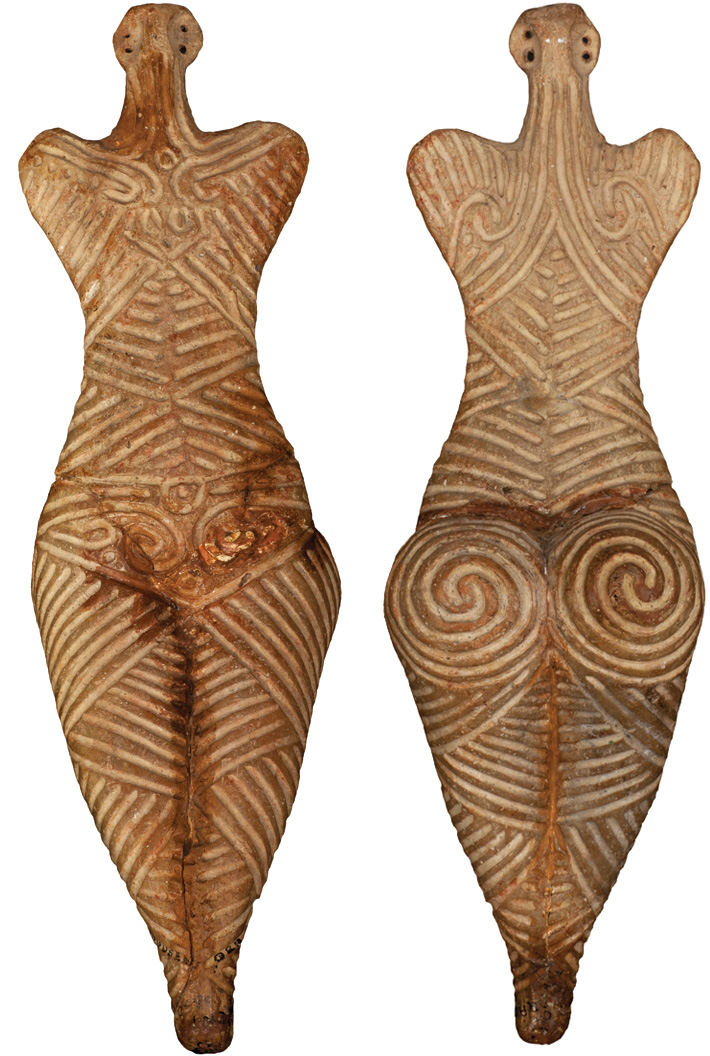 In 1981, more than 20 ceramic human figurines reclining on chairs and bearing elaborate incised decorations were unearthed in northeastern Romania. They, and many other figurines like them—such as the one pictured at right—were made by a people we know today as the Cucuteni culture, which lasted from 4800 to 3000 B.C. in what is now Romania and Ukraine. Some scholars have interpreted these lines as representations of body modification. “They could be tattoos,” says San Francisco State University archaeologist Douglass W. Bailey. “Some say they are clothes, or they could represent something else we don’t understand. We will never know for sure, but in a sense, that’s unimportant. What’s important is that they were using the surface of their bodies to communicate ideas, whether they related to membership in a group or individual identity.” He notes that earlier Paleolithic figurines such as the Venus of Willendorf were unmarked, and that incisions on the bodies of figurines only appear after the beginning of the Neolithic, when ceramics were first made and decorated. “In the Neolithic, people were incising pots by taking a sharp point and cutting away the clay,” says Bailey. “If the pot was a metaphor for the body, that process of engraving could have also been seen as tattooing.” While the practice might have existed in Paleolithic times, there is no evidence for tattooing before 7,000 years ago. Perhaps it was only after the first pots were decorated that people began to contemplate making permanent changes to their own skin’s appearance.
In 1981, more than 20 ceramic human figurines reclining on chairs and bearing elaborate incised decorations were unearthed in northeastern Romania. They, and many other figurines like them—such as the one pictured at right—were made by a people we know today as the Cucuteni culture, which lasted from 4800 to 3000 B.C. in what is now Romania and Ukraine. Some scholars have interpreted these lines as representations of body modification. “They could be tattoos,” says San Francisco State University archaeologist Douglass W. Bailey. “Some say they are clothes, or they could represent something else we don’t understand. We will never know for sure, but in a sense, that’s unimportant. What’s important is that they were using the surface of their bodies to communicate ideas, whether they related to membership in a group or individual identity.” He notes that earlier Paleolithic figurines such as the Venus of Willendorf were unmarked, and that incisions on the bodies of figurines only appear after the beginning of the Neolithic, when ceramics were first made and decorated. “In the Neolithic, people were incising pots by taking a sharp point and cutting away the clay,” says Bailey. “If the pot was a metaphor for the body, that process of engraving could have also been seen as tattooing.” While the practice might have existed in Paleolithic times, there is no evidence for tattooing before 7,000 years ago. Perhaps it was only after the first pots were decorated that people began to contemplate making permanent changes to their own skin’s appearance.
Ötzi, the Iceman
Wednesday, October 09, 2013
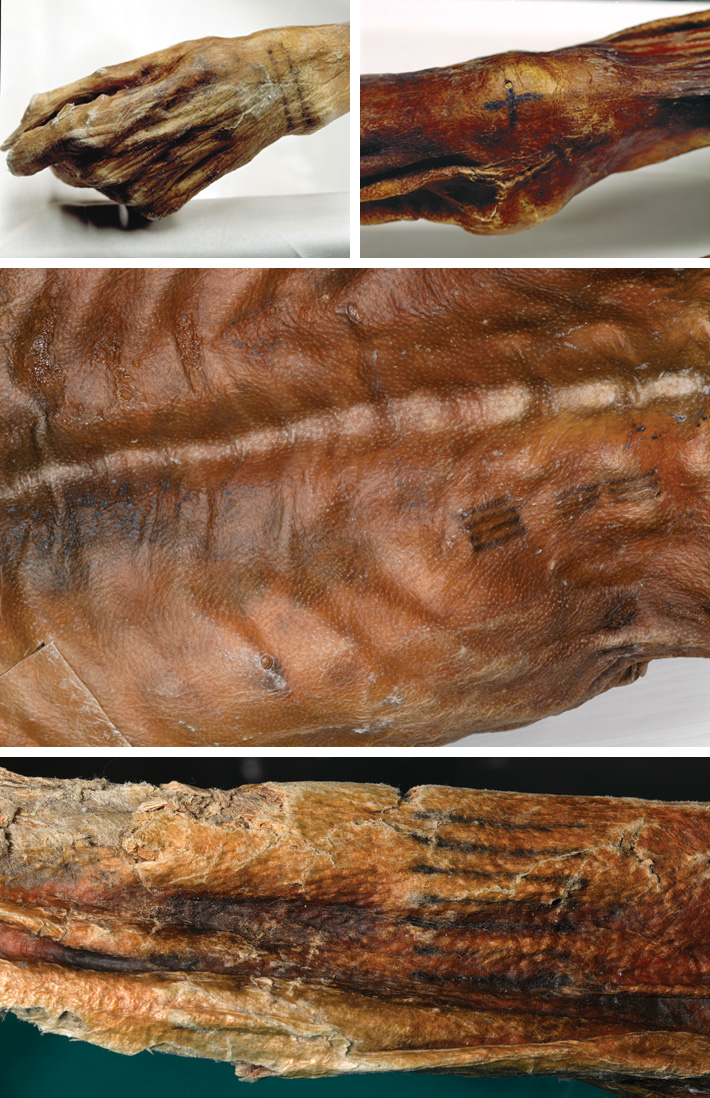 Perhaps the most famous tattooed ancient man is Ötzi the Iceman, who died high in the Italian Alps more than 5,000 years ago. Ötzi’s clothing, tools, and weapons are a remarkable window into the life of a herder or perhaps a chieftain in Copper Age Europe. But it is Ötzi’s body itself, almost perfectly preserved by the snow and ice that covered him shortly after his death, that provides unique evidence of early medicine. Ötzi is covered with more than 50 tattoos in the form of lines and crosses made up of small incisions in his skin into which charcoal was rubbed. Because they are all found on parts of the body that show evidence of a lifetime of wear and tear—the ankles, wrists, knees, Achilles tendon, and lower back, for example—it’s thought that Ötzi’s tattoos were therapeutic, not decorative or symbolic. When Ötzi was first studied, archaeologists were shocked because they had never before seen Copper Age tattoos, and because acupuncture as a treatment for joint distress, rheumatism, and arthritis was thought to have originated in Asia more than 2,000 years later.
Perhaps the most famous tattooed ancient man is Ötzi the Iceman, who died high in the Italian Alps more than 5,000 years ago. Ötzi’s clothing, tools, and weapons are a remarkable window into the life of a herder or perhaps a chieftain in Copper Age Europe. But it is Ötzi’s body itself, almost perfectly preserved by the snow and ice that covered him shortly after his death, that provides unique evidence of early medicine. Ötzi is covered with more than 50 tattoos in the form of lines and crosses made up of small incisions in his skin into which charcoal was rubbed. Because they are all found on parts of the body that show evidence of a lifetime of wear and tear—the ankles, wrists, knees, Achilles tendon, and lower back, for example—it’s thought that Ötzi’s tattoos were therapeutic, not decorative or symbolic. When Ötzi was first studied, archaeologists were shocked because they had never before seen Copper Age tattoos, and because acupuncture as a treatment for joint distress, rheumatism, and arthritis was thought to have originated in Asia more than 2,000 years later.
Dogu Figurine
Wednesday, October 09, 2013
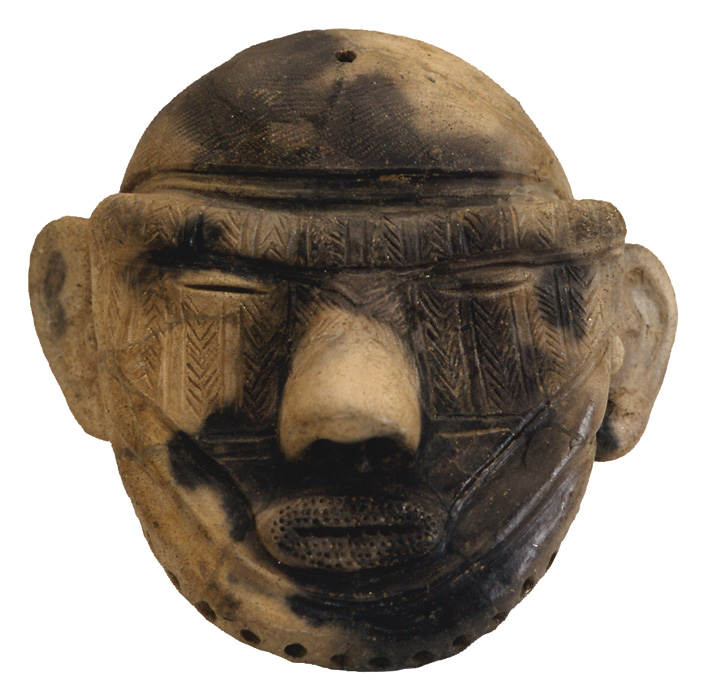 In the 1870s, the Japanese government banned body modification among the Ainu, a small indigenous group who were once renowned for intricate face and arm tattoos. Philippe Dallais of the Museum of Ethnography in Neuchatel, Switzerland, believes they were the last practitioners of a tradition that stretched back thousands of years to the Jōmon people. Hunter-gatherers who eventually became sedentary, the Jōmon developed a complex culture that lasted from 12,000 to 300 B.C. Archaeologists excavating Jōmon houses often unearth humanoid earthenware figurines known as Dogu that sport engravings on their faces and bodies. “I believe these marks in many cases represent tattoos,” says Dallais. “You often find them on arms and around the mouth and eyebrows, just like the tattoos of the Ainu.” No obvious tattooing tools have been found at Jōmon sites, but Dallais says stone tools could have been used to make them. “You have obsidian everywhere in Japan, and it’s possible to take a piece and quickly make small, neat incisions for tattooing.”
In the 1870s, the Japanese government banned body modification among the Ainu, a small indigenous group who were once renowned for intricate face and arm tattoos. Philippe Dallais of the Museum of Ethnography in Neuchatel, Switzerland, believes they were the last practitioners of a tradition that stretched back thousands of years to the Jōmon people. Hunter-gatherers who eventually became sedentary, the Jōmon developed a complex culture that lasted from 12,000 to 300 B.C. Archaeologists excavating Jōmon houses often unearth humanoid earthenware figurines known as Dogu that sport engravings on their faces and bodies. “I believe these marks in many cases represent tattoos,” says Dallais. “You often find them on arms and around the mouth and eyebrows, just like the tattoos of the Ainu.” No obvious tattooing tools have been found at Jōmon sites, but Dallais says stone tools could have been used to make them. “You have obsidian everywhere in Japan, and it’s possible to take a piece and quickly make small, neat incisions for tattooing.”
Faience Figurine and Bowl
Wednesday, October 09, 2013
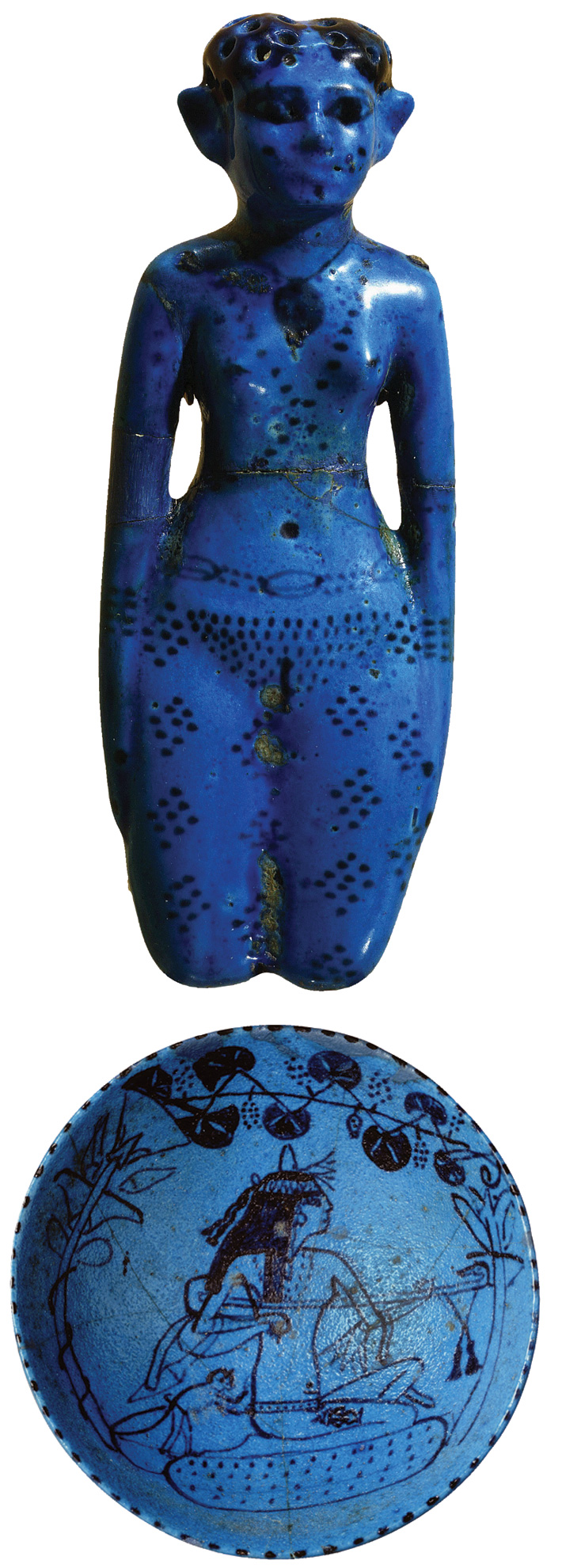
Among cultures known to have practiced tattooing, the ancient Egyptians appear to be the only one in which tattoos may have been the sole province of women. There are several examples of actual tattooed women, including the mummy of Amunet, a priestess of the goddess Hathor, which was discovered in 1891. However, ceramic figurines and vessels depicting tattooed women offer much more evidence. In the Middle Kingdom, footless faience figurines sometimes known as “Brides of the Dead” were created with patterns of lines and diamonds, primarily on their abdomens, but sometimes on their thighs as well. Although likely not a portrait of any individual, this example (left top) is of a type of figurine often found in homes, temples, and tombs, functioning as household items, offerings to the gods, or accompaniments for the dead. In addition to the tattoos, which are seen as sexually suggestive, the figurines often wear belts made of cowry shells, a symbol of femininity, and would have had copious amounts of hair—which was considered especially erotic—attached through holes in the head. Thus, it’s likely that the tattoos were considered one element of a woman’s sexuality, and that they may have been included in the tombs to continue the deceased’s sex life. Because some figurines have been found in female tombs, it’s also possible that they functioned as images of ideal femininity, of which tattoos were an important part. In the New Kingdom a novel kind of tattoo was added to the Egyptians’ repertoire. Women, especially musicians and dancers (left bottom), were sometimes depicted with images of the dwarf god Bes on their thighs, in addition to the more traditional geometric patterns. The Egyptians worshipped Bes as a protector of women in labor, children, and the home.
Lapita Fragment and Engraving
Wednesday, October 09, 2013
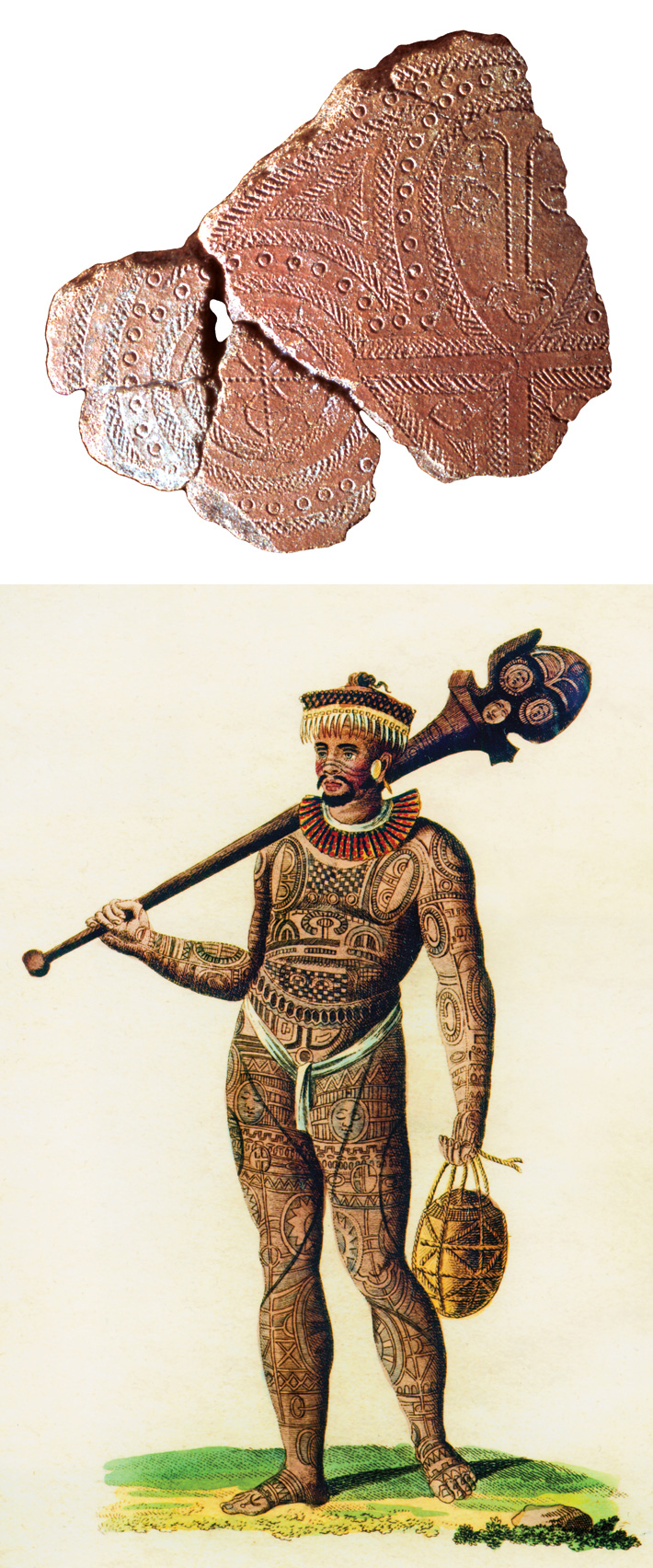
Captain Cook was the first to use the verb “tattoo” in English in 1769, when he described the Tahitian art of tatau in his diary. Now people all around the world bear Polynesian-inspired tattoos, but the first to wear those famous designs were likely the Lapita, who lived from around 1500 to 500 B.C. and are the ancestors of many of today’s Pacific peoples. No direct evidence of Lapita tattooing exists, but University of California, Berkeley, archaeologist Patrick Kirch says that the intricate designs they incised on their pottery resemble tattoo motifs that are still used today and were made by the same toothlike implements that can still be used to create tattoos. “These vessels were being decorated the same way as the body and might represent ancestors,” says Kirch, who thinks these “tattooed pots,” which were thick and crudely made, were probably intended for display during ceremonial occasions. The Lapita used slender, undecorated pottery for utilitarian purposes, such as storing water. Kirch notes that in ethnographic accounts of Oceanic societies, women were responsible for making pottery and men were responsible for tattoos. “It’s possible the Lapita women were creating the skillfully made pottery that actually had to be used, and men were making terrible pottery and decorating it with tattoos.”
Advertisement
Advertisement
IN THIS ISSUE
Advertisement

Recent Issues
-
 May/June 2024
May/June 2024
-
 March/April 2024
March/April 2024
-
 January/February 2024
January/February 2024
-
 November/December 2023
November/December 2023
-
 September/October 2023
September/October 2023
-
 July/August 2023
July/August 2023
-
 May/June 2023
May/June 2023
-
 March/April 2023
March/April 2023
-
 January/February 2023
January/February 2023
-
 November/December 2022
November/December 2022
-
 September/October 2022
September/October 2022
-
 July/August 2022
July/August 2022
-
 May/June 2022
May/June 2022
-
 March/April 2022
March/April 2022
-
 January/February 2022
January/February 2022
-
 November/December 2021
November/December 2021
-
 September/October 2021
September/October 2021
-
 July/August 2021
July/August 2021
-
 May/June 2021
May/June 2021
-
 March/April 2021
March/April 2021
-
 January/February 2021
January/February 2021
-
 November/December 2020
November/December 2020
-
 September/October 2020
September/October 2020
-
 July/August 2020
July/August 2020
-
 May/June 2020
May/June 2020
-
 March/April 2020
March/April 2020
-
 January/February 2020
January/February 2020
-
 November/December 2019
November/December 2019
-
 September/October 2019
September/October 2019
-
 July/August 2019
July/August 2019
-
 May/June 2019
May/June 2019
-
 March/April 2019
March/April 2019
-
 January/February 2019
January/February 2019
-
 November/December 2018
November/December 2018
-
 September/October 2018
September/October 2018
-
 July/August 2018
July/August 2018
-
 May/June 2018
May/June 2018
-
 March/April 2018
March/April 2018
-
 January/February 2018
January/February 2018
-
 November/December 2017
November/December 2017
-
 September/October 2017
September/October 2017
-
 July/August 2017
July/August 2017
-
 May/June 2017
May/June 2017
-
 March/April 2017
March/April 2017
-
 January/February 2017
January/February 2017
-
 November/December 2016
November/December 2016
-
 September/October 2016
September/October 2016
-
 July/August 2016
July/August 2016
-
 May/June 2016
May/June 2016
-
 March/April 2016
March/April 2016
-
 January/February 2016
January/February 2016
-
 November/December 2015
November/December 2015
-
 September/October 2015
September/October 2015
-
 July/August 2015
July/August 2015
-
 May/June 2015
May/June 2015
-
 March/April 2015
March/April 2015
-
 January/February 2015
January/February 2015
-
 November/December 2014
November/December 2014
-
 September/October 2014
September/October 2014
-
 July/August 2014
July/August 2014
-
 May/June 2014
May/June 2014
-
 March/April 2014
March/April 2014
-
 January/February 2014
January/February 2014
-
 November/December 2013
November/December 2013
-
 September/October 2013
September/October 2013
-
 July/August 2013
July/August 2013
-
 May/June 2013
May/June 2013
-
 March/April 2013
March/April 2013
-
 January/February 2013
January/February 2013
-
 November/December 2012
November/December 2012
-
 September/October 2012
September/October 2012
-
 July/August 2012
July/August 2012
-
 May/June 2012
May/June 2012
-
 March/April 2012
March/April 2012
-
 January/February 2012
January/February 2012
-
 November/December 2011
November/December 2011
-
 September/October 2011
September/October 2011
-
 July/August 2011
July/August 2011
-
 May/June 2011
May/June 2011
-
 March/April 2011
March/April 2011
-
 January/February 2011
January/February 2011
Advertisement






